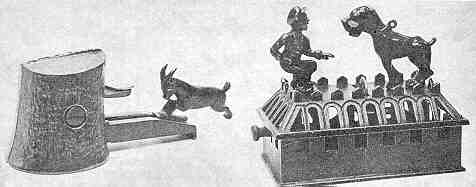Butting Goat (Tree Stump)
Boy and Bull Dog
by F.H. Griffith - HOBBIES Magazine - January, 1969

The H.L. Judd Company who specialized in small simple action banks again comes into the picture as we reach this point in the numerical classification. The mechanicals they manufactured, in their day, seemed to have reached a certain degree of popularity, however, today they are rather difficult to find as originals.
As previously mentioned some time ago, the simplicity of their banks as to construction and mechanism made them ready targets for recasting by certain individuals. Some of the recasting of the Judd banks was done 25 or more years ago, and others in more recent years.
While in either case the recasts can be judged as such, strange to say the old recasts can be identified, in most cases, as compared to the more recent recasts. The way things are going it’s entirely possible that we will hear that an old recast has greater value than a more recent recast.
Actually, for example, there are collectors today who have a certain interest in the old fake banks such as the Carnival, Long May It Wave, and so on. The converted Ferris Wheel Toy is another example. There are two types of this fake originally converted by two different individuals some years ago. The alteration of the Ferris Wheel into a mechanical bank still goes on, so we have recent examples and others with some age.
To conclude this for now and get back to the Judd banks — there is a possible area of understanding of a certain amount of interest in certain of the old fake banks that were created to fool collectors. That is to say they were "original" creations as such, and not just recast banks. This is not to be interpreted as defending them, only to understand the possible interest on the part of several collectors. The writer does not share this interest as he stays strictly with authentic mechanical banks only, and where recasts are concerned he is particularly vehement.
The Judd line of banks form an interesting group and include such mechanicals as the Bucking Mule (Miniature) (HOBBIES, April, 1963), Bull Dog Standing and Bear And Tree Stump (HOBBIES, March, 1966), Mosque Bank, Dog On Turntable, Gem, several others, and the Butting Goat (Tree Stump), No. 169 and the Boy And Bull Dog, No. 170 in the numerical classification.
The Butting Goat (Figure 1) is an extra nice example of this fine little bank. This particular one has the type finish designated by Judd in their old catalog as "copper bronze" with a black goat. The writer just recently found in another old catalog that the bank was also finished in what Judd called "black and yellow finish." In this case the goat is the yellow referred to.
To operate the bank the goat is manually pulled back on the slide into the position shown in the picture. A coin is then placed on the tree stump holder as shown in photo. A light upward touch on the goat’s tail causes him to spring forward butting the coin into the stump. Simple but effective action in an interesting small bank. Coins are removed by turning the force held bolt in the tree stump and taking the bank apart. The head of the bolt is shown in the photograph and gives the appearance of a slot headed screw. This is not the case — it is not a slot but rather a line mark left by the casting.
The Boy And Bull Dog (Figure 2), like the Butting Goat, is rather difficult to find with respect to an original example. Unlike the Butting Goat, however, a few examples of the Boy And Bull Dog exist in bronze. Some of these are original patterns discovered years ago and assembled into working banks. These patterns were used at the time (before assembly) to make a number of recast banks, and these are the recasts that are the most difficult to recognize without close scrutiny. This, of course, due to the fact that an actual pattern was used rather than a production bank. Fortunately they are recognizable for what they are, and of all things cotter pins in some cases where used to hold the boy and dog in place inside the recast bank.
The Boy And Bull Dog shown is done in what Judd called "maroon finish" which is simply a lacquer or japanned type finish. It also came in what they called "ebony and gold" which was black with possible gold highlighting.
To operate the bank a coin is first placed in the provided slot in the center of the bank as shown in the photo. On pulling the lever (shown left in photo) the dog rears back and the boy tilts forward as the coin drops into the bank. Releasing the lever causes the figures to assume the positions as in the picture — ready for another coin. A note of interest is that Judd made a desk paperweight also of cast iron utilizing the same two figures, they did not move, however, and were cast stationary on a flat base.
In closing, the time period of the two banks bears mention, particularly since they apparently were not patented items. Here old catalogs are helpful in establishing the date. They are both in the 1880’s and were for sale by C.F. Rice of Chicago in their 1887 catalog.
